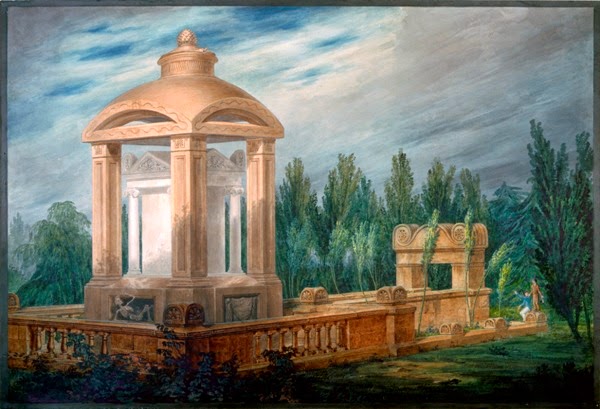This post, by guest blogger Jo Manning, originally ran in 2014. Since the newly restored Pitzhanger Manor has just been re-opened to the public, we thought you might like to follow the progress of the work from then till now.


Sir John Soane could not have been more prominent in his time. He was the Architect to the Bank of England; Surveyor to the Royal Hospital at Chelsea; Grand Superintendent of Works for the Freemasons; and responsible for the interiors of Numbers 10 and 11 Downing Street as well as the Law Courts at Westminster.
Soane designed a number of new buildings adjacent to Sir Christopher Wren’s Royal Hospital at Chelsea. One of them, the Infirmary, was destroyed in WWII; the Stables (which are private but can be seen from Royal Hospital Road) is also his work and has been called “the most quintessentially Soanic” of all Soane’s exteriors; he also designed the Secretary’s Office of the Royal Hospital complex, which now houses the Museum (open to the public).
Soane’s residence in Lincoln’s Inn Fields was more than a private home; it was built to hold much of his art collection, which included architectural drawings, paintings, sculpture, architectural models, and his many and diverse artifacts (including the sarcophagus of Pharoah Seti I, excavated in Egypt’s Valley of the Kings in 1817; the British Library passed on buying it, so Soane bought it!)
As the architect for the Bank of England and its offices, an undertaking that occupied him for at least 45 years, of particular note was the Bank Stock Office, considered, in 1793, to be “daringly unconventional.” He also designed the Dulwich Picture Gallery, recently described by The Sunday Telegraph as “the most beautiful art gallery in the world”. It was the first public picture gallery in England and is said to have influenced a number of galleries that came after. It is often remarked that the museum’s collection stands a far distant second to the magnificent design of the gallery itself.


In 1843 it became home to the daughters of Britain’s only assassinated Prime Minister, Spencer Perceval. In 1901, the building was sold to Ealing District Council and extended to become a public library; in 1985 it was converted into a museum.

In April 2012, Pitzhanger Manor was awarded a first-round development grant of £275,000 from the Heritage Lottery Fund (HLF) and Ealing Council agreed to allow the Pitzhanger Manor Trust (PMT)- a registered charity- to take over management and operation of the house and gallery. Furthermore, £425,000 was been awarded from several charitable trusts and foundations which fund heritage and arts projects, which are subject to the success of the second round bid from HLF. At the time, the Chair of PMT, Sir Sherard Cowper-Coles, said: “We are looking forward to the time when we take responsibility for Pitzhanger Manor Gallery, the new café and community facilities, all within the wonderfully restored Walpole Park. I have no doubt that once completed it will be the jewel in the crown of the queen of the suburbs.”
Here are photos of the gorgeous interiors –
In early May 2014, my husband and I went to an exhibit at the Pitzhanger Art Gallery. The speaker was an expert on Le Corbusier and his massive photographs of Corbu’s work adorned the walls of the gallery space. It was an excellent, well-publicized exhibit that drew many participants. The renovated house and grounds of Pitzhanger Manor will bring in many more tourists and visitors, who will, finally, honor the great architect and designer Sir John Soane in the way he should be honored. It will also be a tremendous resource for young people studying the arts. What a coup for Ealing! Bravo to the Ealing Council and the people of Ealing for their successful efforts in bringing this about.












Interesting post, amusing quote from the child! I hadn't realised the interior was restored, and will go and visit it on my next outing around London! It would have been nice to see the pictures a little larger to examine the detail, I suspect that in years to come, the conservatory will be removed and replaced by something more elegant. It is so easy to put a box on a building and assume it will somehow disappear.
Thank you, Jenny Woolf! That's my 8-year-old granddaughter Lily who made the diorama for a school project. This spot is a lovely place, indeed, and I am so pleased it is getting more attention and will bring more visitors to Ealing, Queen of the Suburbs 🙂